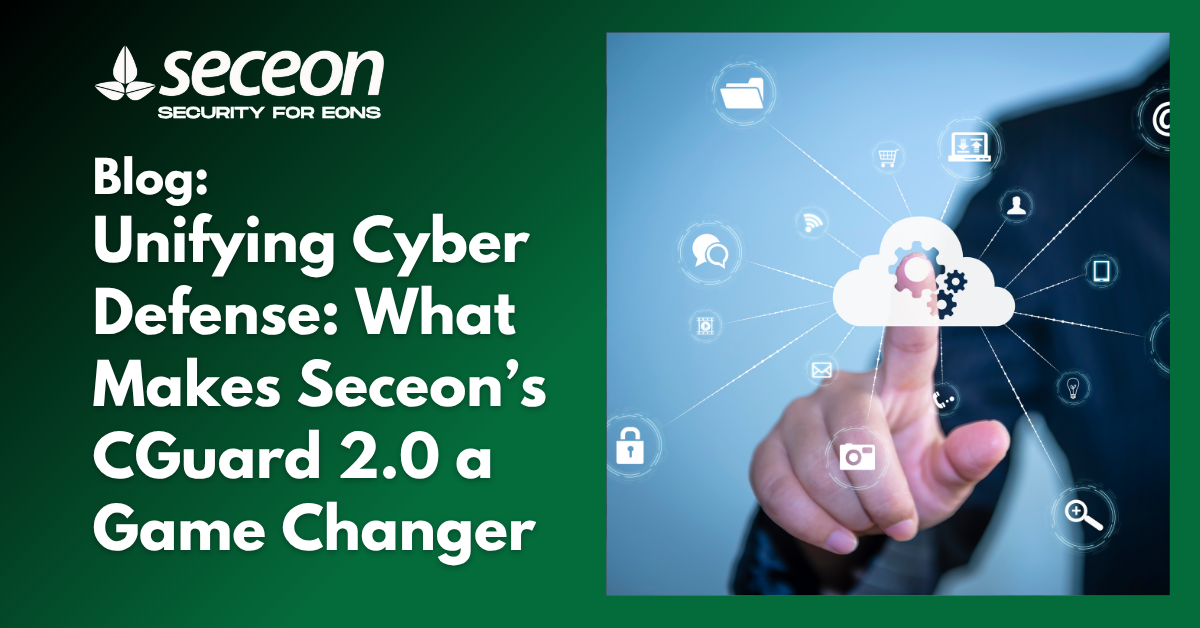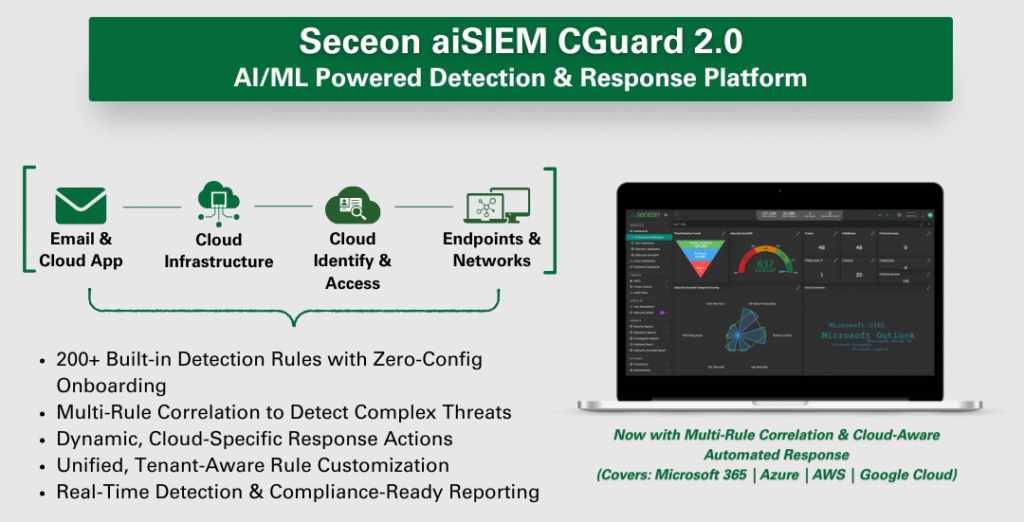
In today’s hyper-connected world, digital ecosystems span across on-premises data centers, public and private clouds, containers, SaaS platforms, and remote endpoints. As this landscape expands, so does the attack surface—and with it, the complexity of defending it. Security teams now juggle dozens of tools, each specialized for a single layer of defense, but collectively creating a fragmented and reactive security posture.
CGuard 2.0, the latest advancement in Seceon’s Open Threat Management (OTM) Platform, redefines what unified cybersecurity means. By seamlessly blending AI-driven detection, behavioral analytics, and automated response, CGuard 2.0 gives organizations the ability to detect, correlate, and respond to threats across their entire digital estate—from cloud workloads and containers to identities, networks, and endpoints.
Let’s explore how CGuard 2.0 is reshaping the landscape of modern cybersecurity and empowering organizations to achieve truly unified cyber defense.
The Cybersecurity Challenge: Fragmentation and Complexity
Most enterprises have assembled their defenses over time—adding a new tool for every new risk. Firewalls, EDRs, SIEMs, SOAR platforms, vulnerability scanners, and cloud posture managers all play vital roles, but managing them collectively can become a nightmare.
This fragmentation results in:
Security operations centers (SOCs) become reactive firefighting units rather than proactive defenders.
Cloud-Native Threats and Evolving Attack Surfaces
The rapid migration to cloud and hybrid environments introduces entirely new risks:
Traditional on-premise tools lack the agility and context needed to detect such threats. What’s needed is a single, cloud-aware defense platform that understands and unifies all signals—this is where CGuard 2.0 comes in.
Seceon OTM: The Foundation for Unified Defense
Seceon’s Open Threat Management (OTM) Platform was designed to eliminate silos by merging threat detection, analytics, and response into one powerful framework. It integrates the capabilities of SIEM, XDR, SOAR, UEBA, NDR, and CSPM—all orchestrated through a shared AI/ML backbone.
The OTM Architecture at a Glance
At its core, OTM provides:
This cohesive architecture enables true end-to-end situational awareness. CGuard 2.0 extends these capabilities deeper into the cloud and hybrid world.
CGuard 2.0: The Next Evolution of Unified Cyber Defense
What is CGuard 2.0?
CGuard 2.0 is Seceon’s next-generation, AI-powered module within the OTM ecosystem. It’s purpose-built to deliver comprehensive protection across cloud, on-prem, and hybrid environments, providing real-time visibility, intelligent correlation, and automated mitigation.

CGuard 2.0 bridges the traditional gap between network, endpoint, and cloud defenses by combining:
The result: a single defense layer that understands every interaction and acts before threats escalate.
Core Innovations of CGuard 2.0
Multi-Rule and Multi-Signal Correlation
Traditional systems trigger alerts based on single events or rules. CGuard 2.0, however, analyzes multi-rule correlations across users, workloads, and time windows. This means it can detect sophisticated, multi-stage attacks that unfold slowly—such as lateral movements or privilege escalations—long before traditional tools would notice.
Advanced AI and Explainable Machine Learning
CGuard 2.0’s intelligence is powered by a multi-layered AI engine that includes:
Together, these capabilities drastically reduce false positives and increase detection accuracy, improving SOC efficiency.
Automated, Context-Aware Response
CGuard 2.0 doesn’t just detect—it responds. Leveraging SOAR-style automation, it can execute context-specific actions such as:
Because it understands the cloud provider’s APIs and permissions model, these actions occur instantly—often before the attacker can cause damage.
The Scollector Agent: Lightweight and Agile
Seceon introduced Scollector, a lightweight telemetry agent that seamlessly collects logs, flows, and metrics from any environment. Key benefits include:
This means organizations can achieve comprehensive visibility within hours, not weeks.
Expansive Integration Ecosystem
CGuard 2.0 supports over 900 connectors, spanning firewalls, EDRs, IAM systems, SaaS applications, and cloud providers. This broad integration landscape ensures that every data source—from Azure AD logs to Kubernetes audit trails—feeds into a single, correlated intelligence hub.
Compliance and Reporting Automation
CGuard 2.0 includes built-in compliance templates and dashboards aligned with leading standards. Reports can be auto-generated for audits, saving countless hours of manual effort while ensuring continuous visibility into compliance posture.
Key Use Cases for CGuard 2.0
CGuard 2.0’s unified intelligence engine powers a wide range of security outcomes:
By consolidating these capabilities into one AI-powered platform, organizations gain not only better protection but also simplified operations.
Deployment Flexibility and Scalability
CGuard 2.0 offers multiple deployment models to meet varying needs:
This flexibility ensures that businesses—regardless of size, architecture, or compliance needs—can adopt unified defense without compromise.
Industry Applications
CGuard 2.0’s versatility makes it a powerful choice across diverse sectors:
With over 700+ global partners and 9,000+ customers across 45 countries, Seceon’s ecosystem reinforces trust in CGuard 2.0 as a proven enterprise-grade defense engine.
Considerations for Successful Adoption
Implementing a unified defense solution requires strategy and alignment. Here are key recommendations:
Start Small, Scale Fast
Begin with a focused pilot—perhaps one cloud environment or department. Once success is demonstrated, scale gradually across endpoints, identity systems, and networks.
Optimize Data Ingestion
Unified defense depends on comprehensive data. Ensure key telemetry sources—firewalls, identity providers, cloud APIs—are properly connected. Adjust retention and ingestion settings to balance visibility with cost.
Tune and Train the AI
CGuard 2.0 learns continuously, but initial baselining is vital. Feed it sufficient clean data to define normal patterns, then review anomalies to fine-tune thresholds.
Integrate with Existing Workflows
Seceon’s APIs allow easy integration with ticketing, communication, and DevOps systems. Align incident workflows to avoid automation conflicts or redundant alerts.
Address Governance and Privacy
Automated response should align with your governance framework. Establish approval chains, audit logs, and rollback capabilities where regulatory oversight requires them.
A Real-World Scenario: How CGuard 2.0 Stops a Cloud Attack
Imagine a large enterprise where an attacker gains access through a compromised developer account.
With traditional tools, these steps might appear unrelated—minor anomalies across multiple dashboards.
With CGuard 2.0, the story unfolds differently:
Within minutes, the attack is contained—illustrating the power of unified, automated cyber defense.
The Strategic Value: Beyond Threat Detection
CGuard 2.0 is more than just a detection engine—it’s a platform for security transformation. By consolidating multiple functions into a single AI-driven system, organizations achieve:
This unified approach aligns technology, people, and process to create a proactive security posture rather than a reactive one.
The Future of Unified Cyber Defense
CGuard 2.0 represents a significant step toward autonomous security operations, but it also sets the stage for the next evolution:
As these trends mature, Seceon’s OTM ecosystem will continue to drive innovation at the intersection of automation, intelligence, and trust.
Conclusion
CGuard 2.0 stands as a milestone in Seceon’s journey to simplify and strengthen cybersecurity through unified intelligence. It converges the worlds of SIEM, SOAR, XDR, and cloud security into a single, AI-powered platform that sees, understands, and acts—instantly. By empowering organizations to move from reactive defense to proactive protection, CGuard 2.0 doesn’t just evolve cybersecurity—it redefines it. For enterprises and MSSPs seeking a smarter, faster, and more efficient way to safeguard hybrid and cloud environments, Seceon CGuard 2.0 truly represents the future of unified cyber defense.
